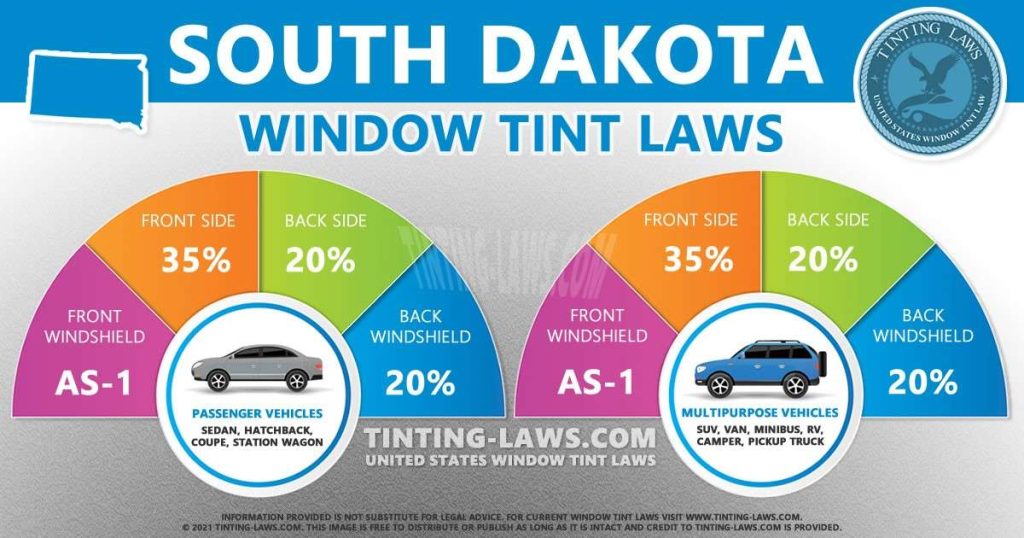South Dakota Window Tinting Laws
Car window tinting laws in South Dakota were enacted in 1989.
We have provided all the necessary information about your car’s window tint, including how dark or reflective the tint is allowed in your state.
There are also additional car window tinting rules and regulations in South Dakota so make sure you read all about it below.
Window tint darkness in South Dakota
The percent of visible light allowed through your car windows is called VLT: Visible Light Transmission.
The percentage of light allowed through your film and glass in South Dakota is very specific and different for sedan cars and SUV cars or vans.
Tint darkness for sedans:
- Windshield: Non-reflective tint is allowed above the manufacturer’s AS-1 line.
- Front Side windows: Must allow more than 35% of light in.
- Back Side windows: Must allow more than 20% of light in.
- Rear Window: Must allow more than 20% of light in.
Tint darkness for SUV and vans:
- Windshield: Non-reflective tint is allowed above the manufacturer’s AS-1 line.
- Front Side windows: Must allow more than 35% of light in.
- Back Side windows: Must allow more than 20% of light in.
- Rear Window: Must allow more than 20% of light in.
Window tint reflection in South Dakota
Window tint can reflect incoming light and reduce glare and heat.
South Dakota window tint law permits a certain window reflection when using a tint so make sure you pay attention to this as well.
Tint reflection for sedans:
- Front Side windows: No metallic or mirrored appearance.
- Back Side windows: No metallic or mirrored appearance.
Tint reflection for SUV and vans:
- Front Side windows: No metallic or mirrored appearance.
- Back Side windows: No metallic or mirrored appearance.
Other South Dakota window tint rules and regulations:
South Dakota does have several other important laws, rules and regulations pertaining to window tinting. They include the following:
- Side Mirrors: There are no restrictions on side mirrors in South Dakota.
- Restricted Colors: No colors of tint are explicitly restricted.
- Tint Variance: 9% variance.
- Certificates: Film manufacturers need to certify the film they sell in South Dakota. Check with your dealer if they are using certified film.
- Stickers: The sticker to identify legal tinting is required between the film & glass on each tinted window.
- Medical Exceptions: South Dakota law does not allow any medical exemptions that would allow using special car window tint.
- Penalties: Class 2 misdemeanor.
Keep in mind that South Dakota tinting laws and regulations may be interpreted differently in your county or place of residence.
We always recommend double-checking our information with your local DMV or law enforcement authorities.

South Dakota Tint Laws Our information about window tint laws in South Dakota was last updated in 2024.
Tinting laws in South Dakota were enacted in 1989.
In case any of our info provided is not up to date or correct be sure to contact us so we can fix it. Thanks!
Trusted industry leader in providing accurate window tint laws. Share with confidence:
State of South Dakota Info
South Dakota is a state located in the Midwestern region of the United States.
It is named after the Lakota and Dakota Sioux American Indian tribes.
South Dakota is the 17th most extensive, but the 5th least populous and the 5th least densely populated of the 50 United States.

Once the southern portion of the Dakota Territory, South Dakota became a state on November 2, 1889 simultaneously with North Dakota.
Pierre is the state capital and Sioux Falls, with a population of 159,000, is South Dakota’s largest city.
Capital: Pierre
Population: 895,376
Area: 77,116 sq mi (199,905 km2)
Cities in South Dakota: Sioux Falls, Rapid City, Deadwood, Brookings, Sturgis, Pierre, Pine Ridge Indian Reservation, Spearfish, Yankton, Vermillion, Aberdeen, Watertown, Mitchell, Hot Springs, Rosebud Indian Reservation, Dupree, Keystone, Belle Fourche, Custer, Huron, Lead, Hill City, De Smet, Mobridge, Oral, Madison, Milbank, Winner, Brandon, Cheyenne River Indian Reservation, Onida, Dakota Dunes, Box Elder, Corsica, Chamberlain, Sisseton, Tea, Dell Rapids, Wall, Summerset, Canton, Faith, Holabird, Shindler, Interior, Eagle Butte, Flandreau, Murdo, Nemo, Harrisburg
Counties in South Dakota: Armstrong, Aurora, Beadle, Bennett, Bon Homme, Boreman, Brookings, Brown, Brule, Buffalo, Butte, Campbell, Charles Mix, Choteau, Clark, Clay, Codington, Corson, Custer, Davison, Day, Delano, Deuel, Dewey, Douglas, Edmunds, Ewing, Fall River, Faulk, Grant, Gregory, Haakon, Hamlin, Hand, Hanson, Harding, Hughes, Hutchinson, Hyde, Jackson, Jayne, Jerauld, Jones, Kingsbury, Lake, Lawrence, Lincoln, Lugenbeel, Lyman, Marshall, Martin, McCook, McPherson, Meade, Mellette, Meyer, Miner, Minnehaha, Moody, Nowlin, Pennington, Perkins, Potter, Pratt, Presho, Rinehart, Roberts, Rusk, Sanborn, Schnasse, Scobey, Shannon, Spink, Stanley, Sterling, Sully, Todd, Tripp, Turner, Union, Wagner, Walworth, Washabaugh, Washington, Yankton, Ziebach
Tint law references:
South Dakota Codified Laws sections 32-15-2.4 through 32-15-5: Sunscreening devices